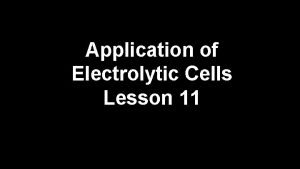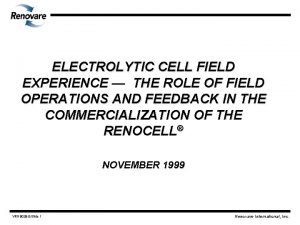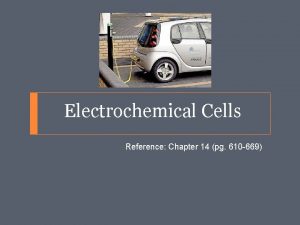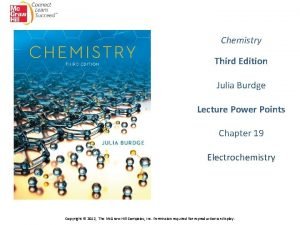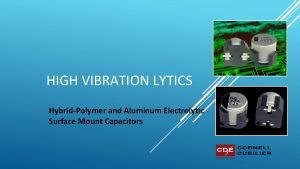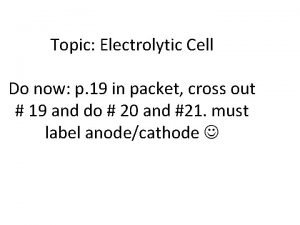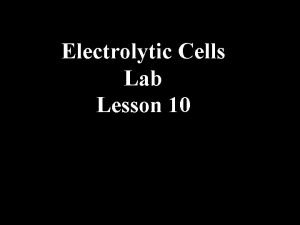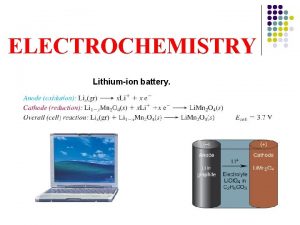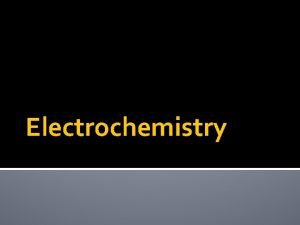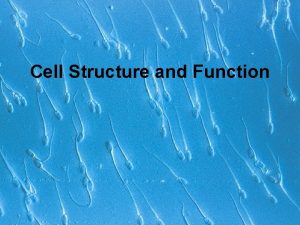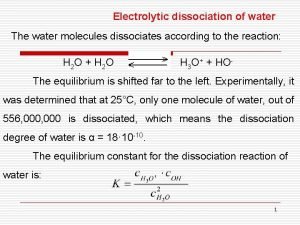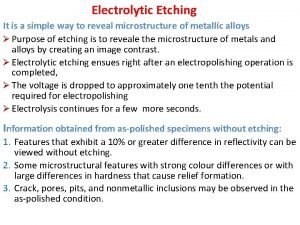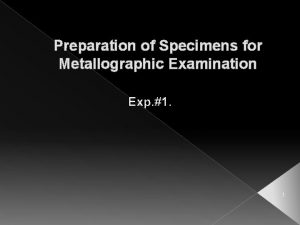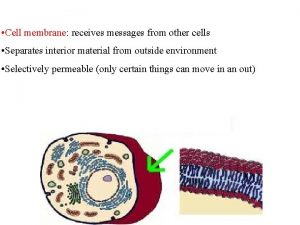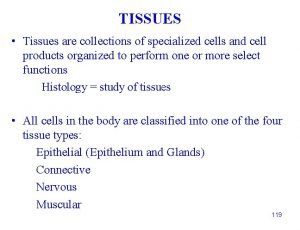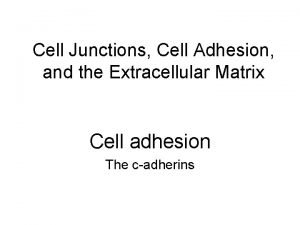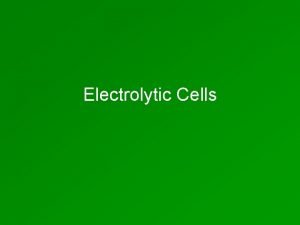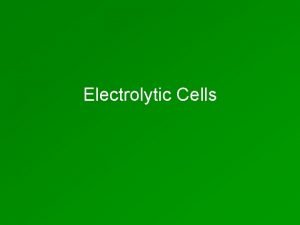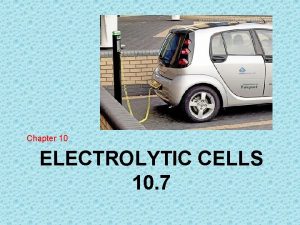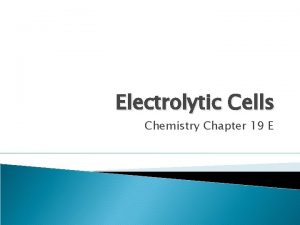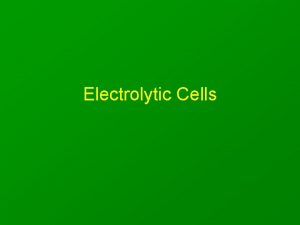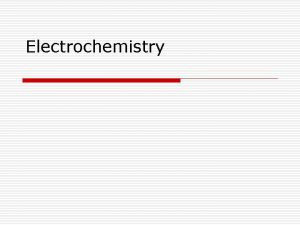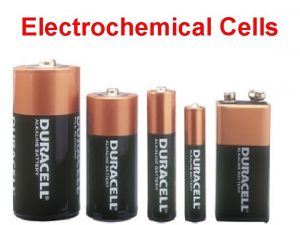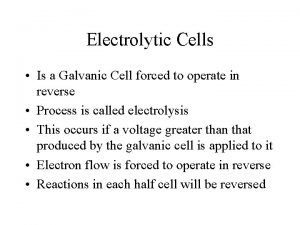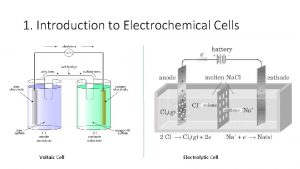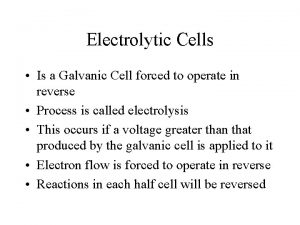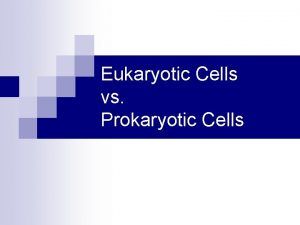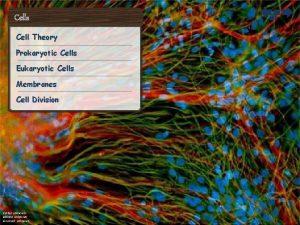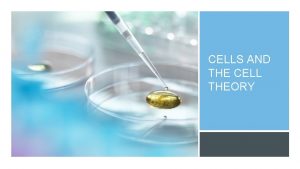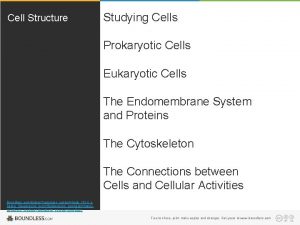Notes on Electrolytic Cells An electrolytic cell is

























































- Slides: 57

Notes on Electrolytic Cells An electrolytic cell is a system of two inert (nonreactive) electrodes (C or Pt) and an electrolyte connected to a power supply. It has the following characteristics 1. 2. 3. Nonspontaneous redox reaction Produces chemicals from electricity Forces electrolysis to occur

When analyzing an electrolytic cell, your first and most important step is to determine the oxidation and reduction reactions. Electrolytic Cell Main Rule The electrode that is connected to the -ve terminal of the power supply will gain electrons and therefore be the site of reduction.

Other Rules: For Electrochemical and Electrolytic Cells Oxidation always occurs at the anode and reduction at the cathode Electrons flow through the wire and go from anode to cathode Anions (- ions) migrate to the anode and cations (+ions) migrate towards the cathode.

1. Draw and completely analyze a molten Na. Br electrolytic cell.

1. Draw and completely analyze a molten Na. Br electrolytic cell. Draw a beaker, two inert electrodes wired to a power supply.

1. Draw and completely analyze a molten Na. Br electrolytic cell. Power Supply DC + Draw a beaker, two inert electrodes wired to a power supply.

1. Draw and completely analyze a molten Na. Br electrolytic cell. Power Supply DC + Label the electrode with Pt or C.

1. Draw and completely analyze a molten Na. Br electrolytic cell. Power Supply DC + Pt Label the electrode with Pt or C. Pt

1. Draw and completely analyze a molten Na. Br electrolytic cell. Power Supply DC + Pt Add the electrolyte Pt

1. Draw and completely analyze a molten Na. Br electrolytic cell. Power Supply DC + Add the electrolyte Molten or liquid means no water! Pt Pt Na+ Br-

1. Draw and completely analyze a molten Na. Br electrolytic cell. Power Supply DC + Label the negative and positive electrodes Pt Pt Na+ Br-

1. Draw and completely analyze a molten Na. Br electrolytic cell. Power Supply DC + Label the negative and positive electrodes Pt Pt _ + Na+ Br-

1. Draw and completely analyze a molten Na. Br electrolytic cell. Power Source + The negative is reduction and the positive is oxidation. Pt Pt _ + Na+ Br-

1. Draw and completely analyze a molten Na. Br electrolytic cell. Power Source + The negative is reduction and the positive is oxidation. Pt Pt _ reduction + oxidation Na+ Br-

1. Draw and completely analyze a molten Na. Br electrolytic cell. Power Source + The anode is oxidation and the cathode is reduction. Pt Pt _ reduction cathode + oxidation anode Na+ Br-

1. Draw and completely analyze a molten Na. Br electrolytic cell. The anion Power Source migrates to the + anode and the cation to the cathode. Pt Pt _ reduction cathode + oxidation anode Na+ Br-

1. Draw and completely analyze a molten Na. Br electrolytic cell. Power Source + The anode reaction is the oxidation of the anion. Pt Pt _ reduction cathode + oxidation anode Na+ Br-

1. Draw and completely analyze a molten Na. Br electrolytic cell. Power Source + Pt Pt _ reduction cathode The anode reaction is the oxidation of the anion. Na+ Br- + oxidation anode 2 Br- → Br 2(g)+ 2 e-

1. Draw and completely analyze a molten Na. Br electrolytic cell. Power Source + Pt Pt _ reduction cathode The Cathode reaction is the reduction of the cation. Na+ Br- + oxidation anode 2 Br- → Br 2(g)+ 2 e-

1. Draw and completely analyze a molten Na. Br electrolytic cell. Power Source + Pt Pt _ reduction cathode 2 Na+ + 2 e- → 2 Na(l) The Cathode reaction is the reduction of the cation. Na+ Br- + oxidation anode 2 Br- → Br 2(g)+ 2 e-

1. Draw and completely analyze a molten Na. Br electrolytic cell. Power Source + Pt Pt _ reduction cathode 2 Na+ + 2 e- → 2 Na(l) Gas Br 2 is produced at the anode. Na+ Br- + oxidation anode 2 Br- → Br 2(g)+ 2 e-

1. Draw and completely analyze a molten Na. Br electrolytic cell. Power Source + Pt Pt _ reduction cathode 2 Na+ + 2 e- → 2 Na(l) Liquid Na is produced at the cathode. Na+ Br- + oxidation anode 2 Br- → Br 2(g)+ 2 e-

1. Draw and completely analyze a molten Na. Br electrolytic cell. The potential for Power Source each half reaction + is calculated and the oxidation sign is reversed Pt Pt _ reduction cathode 2 Na+ + 2 e- → 2 Na(l) Na+ Br- + oxidation anode 2 Br- → Br 2(g)+ 2 e-

1. Draw and completely analyze a molten Na. Br electrolytic cell. The potential for Power Source each half reaction + is listed and the oxidation sign is reversed Pt Pt _ reduction cathode 2 Na+ + 2 e- → 2 Na(l) -2. 71 v Na+ Br- + oxidation anode 2 Br- → Br 2(g)+ 2 e-1. 09 v

1. Draw and completely analyze a molten Na. Br electrolytic cell. The overall redox Power Source reaction is written. - + Pt Pt _ reduction cathode 2 Na+ + 2 e- → 2 Na(l) -2. 71 v Na+ Br- + oxidation anode 2 Br- → Br 2(g)+ 2 e-1. 09 v

1. Draw and completely analyze a molten Na. Br electrolytic cell. The overall redox Power Source reaction is written. - + Pt Pt _ reduction cathode 2 Na+ + 2 e- → 2 Na(l) -2. 71 v Na+ Br- 2 Na+ + 2 Br- → Br 2(g)+ 2 Na(l) + oxidation anode 2 Br- → Br 2(g)+ 2 e-1. 09 v E 0 = -3. 80 v

1. Draw and completely analyze a molten Na. Br The minimum theoretical electrolytic cell. Power Source + voltage MTV required to force this nonspontaneous reaction to occur is the negative of the cell potential. Pt Pt _ reduction cathode 2 Na+ + 2 e- → 2 Na(l) -2. 71 v Na+ Br- + oxidation anode 2 Br- → Br 2(g)+ 2 e-1. 09 v 2 Na+ + 2 Br- → Br 2(g)+ 2 Na(s) E 0 = -3. 80 v

1. Draw and completely analyze a molten Na. Br The minimum theoretical electrolytic cell. Power Source + Pt Pt _ reduction cathode 2 Na+ + 2 e- → 2 Na(l) -2. 71 v 2 Na+ + 2 Br- → Br 2(g)+ 2 Na(s) voltage MTV required to force this nonspontaneous reaction to occur is the negative of the cell potential. Na+ Br- + oxidation anode 2 Br- → Br 2(g)+ 2 e-1. 09 v E 0 = -3. 80 v MTV = +3. 80 v

1. Draw and completely analyze a molten Na. Br Electrons flow through electrolytic cell. Power Source + Pt Pt _ reduction cathode 2 Na+ + 2 e- → 2 Na(l) -2. 71 v 2 Na+ + 2 Br- → Br 2(g)+ 2 Na(s) the wire from anode to cathode. Na+ Br- + oxidation anode 2 Br- → Br 2(g)+ 2 e-1. 09 v E 0 = -3. 80 v MTV = +3. 80 v

1. Draw and completely analyze a molten Na. Br Electrons flow through electrolytic cell. e- the wire from anode to cathode. Power Source + e. Pt Pt _ reduction cathode 2 Na+ + 2 e- → 2 Na(l) -2. 71 v 2 Na+ + 2 Br- → Br 2(g)+ 2 Na(s) Na+ Br- + oxidation anode 2 Br- → Br 2(g)+ 2 e-1. 09 v E 0 = -3. 80 v MTV = +3. 80 v

2. Draw and completely analyze a 1. 0 M KI electrolytic cell.

2. Draw and completely analyze a 1. 0 M KI electrolytic cell. Power Source + Pt Pt

2. Draw and completely analyze a 1. 0 M KI electrolytic cell. Power Source + Add the ions. (aq) or M or solution means water. Pt Pt K+ IH 2 O

2. Draw and completely analyze a 1. 0 M KI electrolytic cell. Label the -, +, anode, cathode, Power Source + oxidation, and reduction. Pt Pt K+ IH 2 O

2. Draw and completely analyze a 1. 0 M KI electrolytic cell. Label the -, +, anode, cathode, Power Source + oxidation, and reduction. Pt Pt Cathode reduction K+ IH 2 O + Anode oxidation

2. Draw and completely analyze a 1. 0 M KI electrolytic cell. The cation and water migrate to the Power Source + cathode Pt Pt Cathode reduction K+ IH 2 O + Anode oxidation

2. Draw and completely analyze a 1. 0 M KI electrolytic cell. The cation and water migrate to the Power Source + cathode Pt Pt Cathode reduction K+ IH 2 O + Anode oxidation

2. Draw and completely analyze a 1. 0 M KI electrolytic cell. The cation or water reduces. The higher Power Source + one on the chart is most spontaneous and occurs. Pt Pt Cathode reduction K+ IH 2 O + Anode oxidation

Cl 2 + 1/2 O 2 + 2 e- → 2 Cl- 2 H+(10 -7 M) + 2 e- 2 H 2 O + 2 e- 1. 36 v → H 20 → 2 H 2 + 2 OH- -0. 42 v Zn 2+ + 2 e- → Zn(s) -0. 76 v K+ + 1 e- → -2. 93 v K(s) 0. 82 v

Cl 2 + 1/2 O 2 + 2 e- → 2 Cl- 1. 36 v 2 H+(10 -7 M) → H 20 0. 32 v Reduction of water 2 H 2 O + 2 e- → 2 H 2 + 2 OH- -0. 42 v Zn 2+ + 2 e- → Zn(s) -0. 76 v K+ + 1 e- → -2. 93 v K(s)

Cl 2 + 2 e- → 2 Cl- 1. 36 v 1/2 O 2 + 2 H+(10 -7 M) → H 20 0. 32 v Oxidation of water Reduction of water 2 H 2 O + 2 e- → 2 H 2 + 2 OH- -0. 42 v Zn 2+ + 2 e- → Zn(s) -0. 76 v K+ + 1 e- → -2. 93 v K(s)

Cl 2 + 2 e- → 2 Cl- 1. 36 v 1/2 O 2 + 2 H+(10 -7 M) → H 20 0. 32 v Oxidation of water Reduction of water 2 H 2 O + 2 e- Zn 2+ Reduction of K+ K+ + + 2 e- 1 e- → → 2 H 2 + 2 OH- -0. 42 v → Zn(s) -0. 76 v K(s) -2. 93 v

Cl 2 + 2 e- → 2 Cl- 1/2 O 2 + 2 H+(10 -7 M) 1. 36 v → H 20 0. 32 v Oxidation of water strongest oxidizing agent or highest select most spontaneous reaction Reduction of water 2 H 2 O + 2 e- → 2 H 2(g) + 2 OH- -0. 42 v Overpotential Effect- treat water as if it were just below Zn Zn 2+ Reduction of K K+ + 2 e- → Zn(s) -0. 76 v + 1 e- → -2. 93 v K(s)

The overpotential effect is a higher than normal voltage required for the half reaction. This is often due to extra voltage required to produce a gas bubble in solution.

2. Draw and completely analyze a 1. 0 M KI electrolytic cell. The cation or water reduces. The higher Power Source + one on the chart is most spontaneous and occurs. Pt Pt Cathode Reduction K+ IH 2 O + Anode oxidation

2. Draw and completely analyze a 1. 0 M KI electrolytic cell. The cation or water reduces. The higher Power Source + one on the chart is most spontaneous and occurs. Pt Pt Cathode Reduction 2 H 2 O+2 e- → 2 H 2+ 2 OH-0. 41 v K+ IH 2 O + Anode oxidation

2. Draw and completely analyze a 1. 0 M KI electrolytic cell. The anion + water goes to the anode. Power Source - + Pt Pt Cathode Reduction 2 H 2 O+2 e- → 2 H 2+ 2 OH-0. 41 v K+ IH 2 O + Anode oxidation

2. Draw and completely analyze a 1. 0 M KI electrolytic cell. For oxidation the most spontaneous Power Source + reaction is found on the redox chart and is lowest. Pt Pt Cathode Reduction 2 H 2 O+2 e- → 2 H 2+ 2 OH-0. 41 v K+ IH 2 O + Anode oxidation

Cl 2 + 2 e- → 2 Cl- 1. 36 v 1/2 O 2 + 2 H+(10 -7 M) + 2 e- → H 20 0. 82 v Oxidation of water I 2(s) + 2 e- → 2 I- 0. 54 v → 2 H 2 + 2 OH- -0. 42 v Reduction of water 2 H 2 O + 2 e- Zn 2+ + 2 e- → Zn(s) -0. 76 v K+ + 1 e- → -2. 93 v K(s)

Cl 2 + 2 e- → 2 Cl- 1. 36 v 1/2 O 2(g) + 2 H+(10 -7 M) → H 20 0. 82 v Oxidation of water I 2(s) 2 I 0. 54 v Oxidation of I- + 2 e- → Reduction of water 2 H 2 O + 2 e- → 2 H 2 + 2 OH- -0. 42 v Zn 2+ + 2 e- → Zn(s) -0. 76 v K+ + 1 e- → -2. 93 v K(s)

Cl 2 + 2 e- → 2 Cl 1. 36 v overpotential effect means water is here 1/2 O 2 + 2 H+(10 -7 M) → H 20 0. 82 v Oxidation of water I 2(s) 2 I 0. 54 v Oxidation of I- + 2 e- → Reduction of water 2 H 2 O + 2 e- → 2 H 2 + 2 OH- -0. 42 v Zn 2+ + 2 e- → Zn(s) -0. 76 v K+ + 1 e- → -2. 93 v K(s)

Cl 2 + 2 e- → 2 Cl 1. 36 v overpotential effect means water is here 1/2 O 2 + 2 H+(10 -7 M) → I 2(s) + 2 e- H 20 0. 82 v Oxidation of water → 2 I 0. 54 v Oxidation of Ipick strongest reducing agent- lower Reduction of water 2 H 2 O + 2 e- → 2 H 2 + 2 OH- -0. 42 v Zn 2+ + 2 e- → Zn(s) -0. 76 v K+ + 1 e- → -2. 93 v K(s)

2. Draw and completely analyze a 1. 0 M KI electrolytic cell. For oxidation the most spontaneous Power Source + reaction is found on the redox chart and is lowest. Pt Pt Cathode Reduction 2 H 2 O+2 e- → 2 H 2+ 2 OH-0. 41 v K+ IH 2 O + Anode Oxidation

2. Draw and completely analyze a 1. 0 M KI electrolytic cell. For oxidation the most spontaneous Power Source + reaction is found on the redox chart and is lowest. Pt Pt Cathode Reduction 2 H 2 O+2 e- → 2 H 2+ 2 OH-0. 41 v K+ IH 2 O + Anode Oxidation 2 I- → I 2(s) + 2 e-0. 54 v

2. Draw and completely analyze a 1. 0 M KI electrolytic cell. Write the overall reaction with the Power Source + cell potential. Pt Pt Cathode Reduction 2 H 2 O +2 e- → 2 H 2+ 2 OH-0. 41 v K+ IH 2 O + Anode Oxidation 2 I- → I 2(s) + 2 e-0. 54 v

2. Draw and completely analyze a 1. 0 M KI electrolytic cell. Write the overall reaction with the Power Source + cell potential. Pt Pt Cathode Reduction 2 H 2 O+2 e- → 2 H 2+ 2 OH-0. 41 v K+ IH 2 O 2 H 2 O+ 2 I- → 2 H 2+ I 2(s) + 2 OH- + Anode Oxidation 2 I- → I 2(s) + 2 e-0. 54 v E 0 = -0. 95 v

2. Draw and completely analyze a 1. 0 M KI electrolytic cell. Write the overall reaction with the Power Source + ecell potential. e. Pt Pt Cathode Reduction 2 H 2 O+2 e- → H 2+ 2 OH-0. 41 v + Anode Oxidation K+ IH 2 O 2 H 2 O+ 2 I- → H 2+ I 2(s) + 2 OH- 2 I- → I 2(s) + 2 e-0. 54 v E 0 = -0. 95 v MTV = +0. 95 v
 Chapter 21 electrochemistry
Chapter 21 electrochemistry Application of electrolytic cell
Application of electrolytic cell Khan academy electrolysis
Khan academy electrolysis Renocell
Renocell Cell notation
Cell notation Applications of electrolytic cell
Applications of electrolytic cell Smt for electrolytic cell
Smt for electrolytic cell Galvanic vs electrolytic cell
Galvanic vs electrolytic cell Electrolytic cell
Electrolytic cell Electrolytic cell notation
Electrolytic cell notation Cathode
Cathode Waters view with open mouth
Waters view with open mouth Dr saja
Dr saja Pineal gland
Pineal gland Somatic cells vs gametes
Somatic cells vs gametes Somatic cells vs germ cells
Somatic cells vs germ cells Red blood cells and white blood cells difference
Red blood cells and white blood cells difference Prokaryote vs eukaryote
Prokaryote vs eukaryote Similarities between plant and animal cells venn diagram
Similarities between plant and animal cells venn diagram Prokaryotic cells
Prokaryotic cells Organelle trail
Organelle trail Masses of cells form and steal nutrients from healthy cells
Masses of cells form and steal nutrients from healthy cells Younger cells cuboidal older cells flattened
Younger cells cuboidal older cells flattened What animals have prokaryotic cells
What animals have prokaryotic cells Is a staphylococcus cell prokaryotic or eukaryotic
Is a staphylococcus cell prokaryotic or eukaryotic Chapter 8 cellular reproduction cells from cells
Chapter 8 cellular reproduction cells from cells Cells cells they're made of organelles meme
Cells cells they're made of organelles meme Joy took the notes shown below while learning about cells
Joy took the notes shown below while learning about cells Dissociated meaning
Dissociated meaning Electrolytic decomposition example
Electrolytic decomposition example Electrolytic etching
Electrolytic etching Electrolytic capacitor polarity
Electrolytic capacitor polarity Electrolytic etching metallography
Electrolytic etching metallography Germ cell vs somatic cells
Germ cell vs somatic cells Collection of specialized cells and cell products
Collection of specialized cells and cell products Facteur g
Facteur g Volvox diagram
Volvox diagram Advantages and disadvantages of diaphragm cell process
Advantages and disadvantages of diaphragm cell process Prokaryotic cell vs eukaryotic cell
Prokaryotic cell vs eukaryotic cell Prokaryotic reproduction
Prokaryotic reproduction Plant cell outline
Plant cell outline S
S Dry cell vs wet cell
Dry cell vs wet cell Function of cells
Function of cells Tonoplast
Tonoplast What is the function of vacuole in the cell
What is the function of vacuole in the cell Cell wall cell membrane
Cell wall cell membrane Cell line vs cell strain
Cell line vs cell strain Finite and continuous cell lines
Finite and continuous cell lines Cell city analogy answer key
Cell city analogy answer key Primary battery and secondary battery
Primary battery and secondary battery Differences between plant animal and bacterial cells
Differences between plant animal and bacterial cells Cell-cell junction
Cell-cell junction Cell-cell junction
Cell-cell junction Which organelle prepares proteins for specific jobs
Which organelle prepares proteins for specific jobs Section 10-2 cell division
Section 10-2 cell division Life
Life Eukaryotic cell animal cell
Eukaryotic cell animal cell

